

[Travel Series] The Picturesque Charms of Fort Kochi
Kochi, or Cochin as it is also called, is a port town that was once a fishing village. The flooding of the Periyar River in 1341 CE transformed its fortunes by creating a natural harbour and making it the centre of maritime trade. Over the years the Arabs, the Portuguese, the Dutch and the British have left their mark on the region, and today’s Kochi is an eclectic mix of bustling commerce, quaint Chinese fishing nets, mosques, churches, the oldest synagogue in the British Commonwealth and Portuguese architecture. Come to Kochi to experience its charming heritage, enjoy the sunset by the beaches, visit the numerous places of worship, wander its bazaars, and get inspired by the unique street art that dots Fort Kochi.
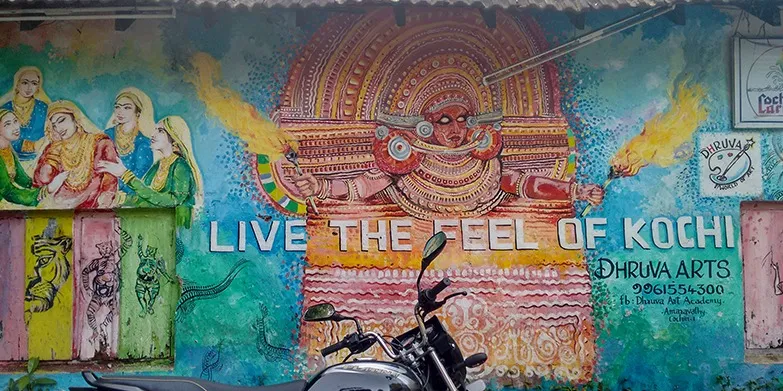
Vibrant Street Art in Fort Kochi
Getting your Bearings
Kochi comprises a few distinct areas – mainland Ernakulam, the islands of Willingdon, Fort Kochi and Mattancherry, Vypin and Bolgatty. The islands are separated from the mainland by the waters of Vembanad Lake. You will likely arrive at Ernakulum from where you can take a taxi, bus or ferry to Fort Kochi – that houses fine homestays, heritage hotels and hostels – and where, I recommend, you base yourself. My bus dropped me off in Ernakulum and on the advice of the locals, I caught a bus first to Thoppumpady and then to Fort Kochi. A ferry from the Main Ferry Station in Ernakulam is a more elegant and picturesque option.
I began my sight-seeing of the city, on Thursday afternoon, by visiting the Tourism Information Office, right by the Chinese nets at the Fort Kochi jetty. The very helpful officer equipped me with a map of the area, gave me valuable information on the ferry system, how to get around Kochi, and directed me to start my visit with the Jewish Synagogue (since it would be closed the following day). Excited about all there was to come, off I went to Jew Town or Mattancherry.
Mattancherry
Mattancherry, in its heyday, was at heart of the bustling spice trade. People from various religions and communities have made it their home and today’s Mattancherry reflects its varied cultural past and present. Must sees here are the Synagogue and the Dutch Palace and a stroll along its colourful streets. Shops selling antiques jostle with those selling curios from Kashmir, local handicrafts and various bric-a-brac and even if you are not in the market for shopping, a walk in the bazaars is a good way to feel the vibe, see the colours and appreciate the local culture.
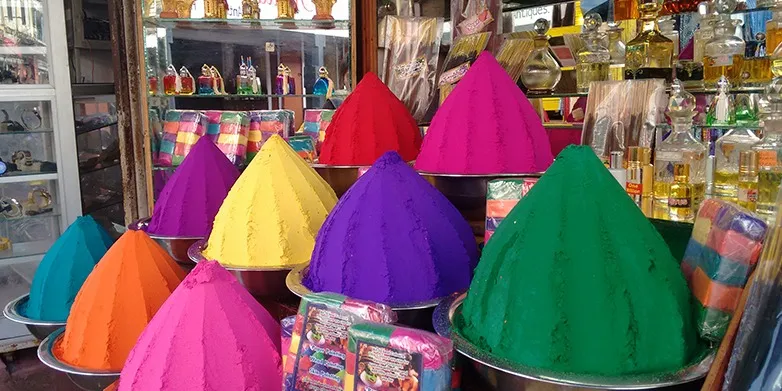
Colours of Kathakali Make-up; Incense shop, Mattancherry
Getting there: Mattancherry lies 3 KM SE of Fort Kochi. About 750 M from the Vypin Ferry Station, is the Ferry Station that connects Fort Kochi to Ernakulum and Mattancherry. Ferry cost is INR 5. Auto rickshaws cost about INR 30 and take the inland route.
Pardesi Synagogue
The oldest in the Commonwealth, where prayers are still offered, the synagogue is also called Pardesi Synagogue, ‘Pardesi’ denoting ‘foreign’. It was built in 1568, but was subsequently destroyed by the Portuguese and rebuilt by the Dutch. Inside, you will find a walk-through exhibition of the Jewish history in India. The interiors have exquisite details such as Belgian Chandeliers and hand-painted porcelain tiles from Canton, China on the floor. It is open 10 AM to 1 PM and 3 PM to 5 PM Sunday to Thursday. The entry fee is INR 5.
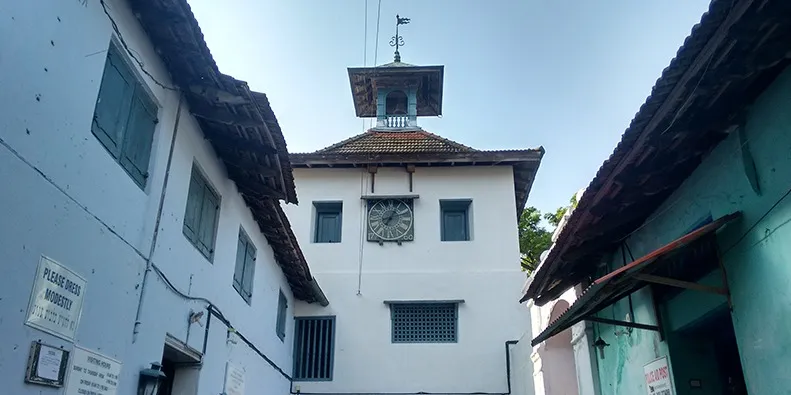
The Jewish Synagogue in Mattancherry
Mattancherry Palace
About 450 M from the Synagogue, in the lane opposite the Boat Jetty, is the Mattancherry Palace. In a bid to make up for their destruction of the local temples, the Portuguese built the palace and presented it to the Indian King in 1555. The Dutch, who came next, renovated it and gave their name to it. The Palace is built in the traditional style of a Kerala house, with four wings opening into a central quadrangle. The floors, like the flooring in Puthenmallika Palace in Thiruvananthapuram, is built with all organic material such as burnt coconut shells, lime, plant juices and egg-whites. There are several exhibits such as statues of Kochi kings, antique weapons, and period furniture. Of note are the exquisite murals depicting scenes from the Ramayana and other Hindu epics, painted between the 17th and 18th century. The entry fee is INR 5 and the timings are from 9 AM to 5 PM Saturday to Thursday.
An Evening In Fort Kochi
Chinese Fishing Nets
A walk through the River Road promenade and along the beach is a relaxing and picturesque way to wrap up the day in Fort Kochi. The Chinese Fishing nets were brought here by the Kublai Khan’s traders, and have a touch of quaint romance about them. Watch the fishermen work the cantilevered bamboo structures that support the huge nets and bring in the haul of fish. Crows sweep in and hopeful cats wait their turn for fish scraps. Various street stalls sell everything from flowers in hair bands, handicrafts, to plastic icing guns. You can even buy the freshly caught fish and have it cooked locally. I sat back with a cup of tea and watched people and the sights, as the sun grudgingly disappeared behind the Monsoon clouds.
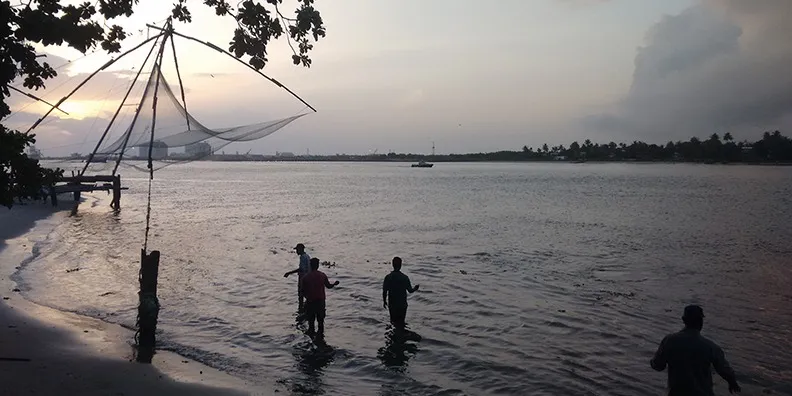
Chinese Fishing Nets on Fort Kochi Beach
Watching a Kathakali Performance
The Kerala Kathakali Centre, near the Santa Cruz Basilica, hosts performances of Kathakali, the traditional dance form, from 5 PM in the evenings. The dance form has a few hallmarks: performed only by men in elaborate costume and make-up, the performance narrates stories from Indian mythologies, accompanied by various musical instruments. For a sum of INR 350, you can watch and understand how the artists put on their make-up for about an hour, followed by the actual dance performance for another hour.
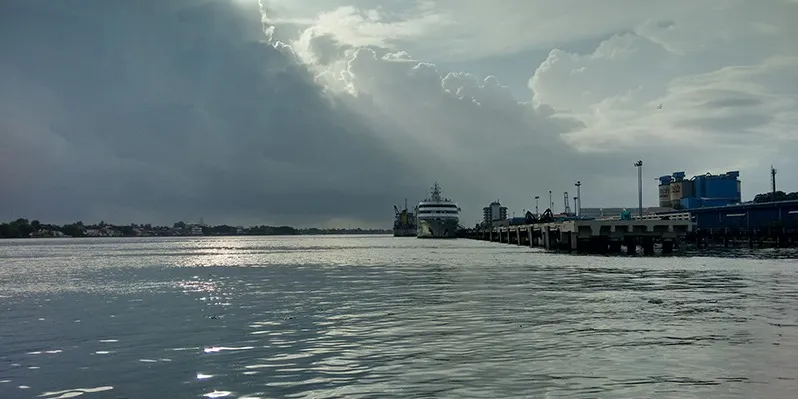
Navigating the islands by ferries is efficient and affords spectacular views
A Walking Tour of Fort Kochi
Having been told that the best way to explore Fort Kochi was by foot, I spent a happy hour over my breakfast of toast and tea, the next day, planning a walking tour of the town. My reference sources were Outlook Traveller’s guide to Kerala, Lonely Planet’s South India and Kerala guide, the map and information from the Tourism Information Office and of course, Google Maps. I identified the attractions I wanted to see and the most efficient route that connected them all. While I ticked off most of the boxes, I did leave a few out, choosing to spend some time savouring a beautiful morning in Fort Kochi, talking to locals and other travellers, and spending time by the beach, watching fishermen at work. I could not have scripted a more perfect morning.
There are paid options for a heritage walking tour, and I further encountered several auto rickshaw drivers keen to show me the various temples and sights. You can opt for these if a self-guided tour is not your cup your tea.
Santa Cruz Basilica
I started my tour with visiting the Santa Cruz Basilica that opens its doors to visitors at 9 AM, before which Mass – that is off limits to tourists – is held. The Portuguese built the church in 1505 and the Pope declared it to be a Basilica in 1984, one of the eight in India. Its graceful façade lead me to cool and dim interiors, and pews that invited me to pause and pray, and to express gratitude for my travels. The stained-glass windows are exquisite, as are the murals on the ceilings.

Side Entrance to Santa Cruz Basilica
Loafer’s Corner
I walked North along KB Jacob Road and turned left onto Bastion Street to reach the iconic Loafer’s corner, the intersection of many streets, and the best spot to get a view of the old warm charm of the Princess Street, one of the first streets to be built in Fort Kochi area.
St. Francis Church
Continuing on Bastion Street, I reached the Vasco House to my right, which is believed to be the residence of Vasco da Gama (the first Portuguese sailor to reach the shores of Kerala) and is one of the oldest residences in Fort Kochi. Further down the road, is St. Francis Church. Built in 1503 by the Portuguese, it is the first European Church in India. Through the years, it’s control passed first to the Dutch and then to the British. It is now run by the Church of South India (CSI). Vasco da Gama died in 1524, on this third visit to Kerala, and his remains were buried here before being shifted to Lisbon in Portugal. His tombstone still stands inside the church. The Church also houses an old Dutch baptism and marriage register (1751 to 1804).

Exterior of St Francis Church
Exterior of St Francis Church
Down the road, leaving St. Francis Church behind, and with Parade Ground on the left, stands David Hall. Associated with the renowned Dutch Commander Hendrik Adriaan Van Reed Tot Drakestein who compiled a pioneering tome on the flora of the Malabar coast, and named after David Koder, a later Jewish resident, David Gall is now a gallery that houses rooms of paintings and a café.
Dutch Cemetery
I found signs leading me to the Dutch Cemetery near the River Road. The cemetery, which was consecrated in 1724, is believed to be the oldest in the country, and is the final resting place for several Dutch and British nationals. The last burial her took place over a hundred years ago. Since it is closed to visitors, I peeped through the gate to catch a glimpse of headstones set against lush greenery.
Colonial houses
The area has several colonial houses from the Dutch era, many of them now converted into heritage hotels. I saw the most graceful and palatial of them all, Thakur House, on the Dutch Cemetery Road on the way to the cemetery. It is now a private residence, and through the front gates, one can see views it sweeping lines. On the River Road and the Tower Road, stand Bastion Bungalow, Old Harbour Hotel and Koder House. Each of these has distinctive architectural features, such as the red brick like exterior of the Koder House and the first-floor wooden verandah of Bastion Bungalow, that you can pause to take in and understand.
Fort Imannuel
Lending the ‘Fort’ in Fort Kochi, Fort Immanuel was built in 1503 CE to demonstrate the alliance of the Maharajah of Kochi and Monarch of Portugal. Attacks by first the Dutch, and then the British, have all but destroyed it and only remnants of the fort can be seen along the beach.

Remnants of Fort Immanuel by the beach
Bishop’s HOUSE and Indo Portuguese Museum
Bishop’s House is some distance away from the beach, on a hillock near the Parade Ground and I followed Google Maps for about 800 M to get to it. Built in 1506 CE, it was the home of the Portuguese Governor. It has impressive Gothic exteriors and shady paths that lead to its main entrance with doors fronted by stained glass. Within the grounds, are the Indo Portuguese Museum that houses artefacts from Portuguese history.
An Afternoon at Kerala Folklore Musuem
In the afternoon, I caught a bus to Thevara from the Fort Kochi bus stand (INR 12) and then an auto rickshaw (INR 40) to reach the Kerala Folklore Museum, before catching my evening train from Ernakulum. One of my favourite stops in Kochi, I strongly recommend a visit to the Museum. Built over three levels, in hallmark Keralan style, the museum is the labour of love of a private collector, George Thaliath, and showcases more than 4000 artefacts collected over a period of 20 years.
Not restricted to Kerala, the exhibits also cover objects from Tamil Nadu and some from Karnataka. I spent over an hour reading the informative labels and admiring the unique displays, getting but a glimpse of the rich and varied cultural heritage of the region. I could have easily spent an entire afternoon there and still not absorbed it all. I am hard pressed to name my favourites – the superbly displayed costumes of the various traditional dance forms, the Theyyam face writing that is a two-thousand-year-old art form, the wall of ancient masks, the intricate temple jewellery – at each turn, I noticed a new and intriguing treasure.
The museum is open from 9:30 AM to 6:00 PM and the entry fee is INR 100 per person with an additional fee of INR 100 for a camera.
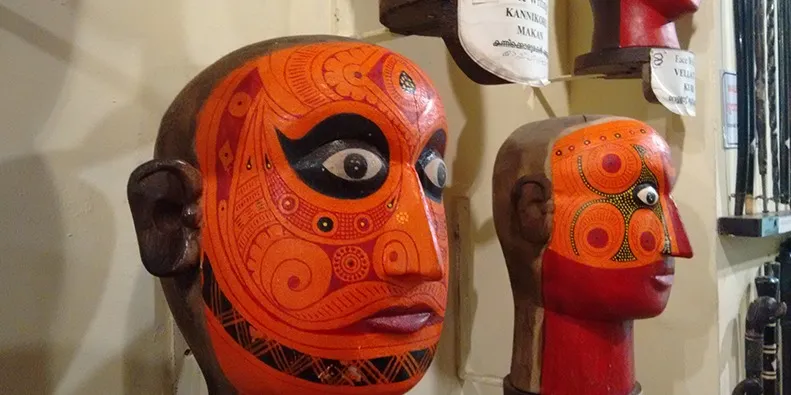
Theyyam Face Writing displays at the Kerala Folklore Museum
Other tips
Staying in Fort Kochi
Fort Kochi sees many travellers with a range of budgets and has accommodation options to cater to all types. I stayed at Hostel by the Sea. As the name suggests, it’s right by the sea, near the boat jetty and the Chinese Fishing Nets. It’s a great location with all sights in Fort Kochi, places to eat and the bus stand within close vicinity.
Places to Eat
● My walk around Fort Kochi revealed some interesting options for an early breakfast. Qissa Café near the KSRTC bus stand has charmingly aesthetic interiors and several unique continental dishes on their menu. I also found Loafer’s café at Loafer’s corner doing bustling trade. A start of eggs and toast at Kushi’s café near the Basilica was just what the doctor had ordered to fortify me for the day
● I had a relaxed lunch at the iconic Kashi’s Art Café in Burgher Street. Set in an old Portuguese Villa, the café offers some excellent food and service, and a cosy and relaxed atmosphere in a semi-open courtyard. A small gallery at the entrance exhibits art by local artists.
● There are several options to eat and drink in Fort Kochi depending on your budget. For dinner, I ate by the roadside, a simple but well-made meal of stew and appams that is traditional Kerala fare. You can also eat Tibetan and Indo Chinese fare at the Tibetan Café near the Kathakali Centre. The options outlined above will cost you between INR 100-400 depending on how many items and what fare you order.
This travel post is a part of Aao hostels fellowship travel series.

![[Travel Series] The Picturesque Charms of Fort Kochi](https://images.yourstory.com/production/document_image/mystoryimage/tw6v5r5t-Kochi-9.jpg?w=1152&fm=auto&ar=2:1&mode=crop&crop=faces)
